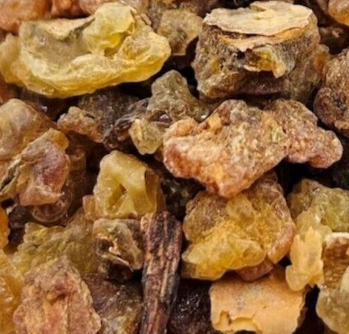Commiphora myrrha resin extract, also known as myrrh extract, is a natural product derived from the resin of the myrrh tree (Commiphora myrrha). It is traditionally used for its medicinal, aromatic properties and as an ingredient in cosmetics and skincare products.
The name describes the structure of the molecule
- "Commiphora" is the botanical genus of the tree from which the resin is derived.
- "myrrha" is the specific species of the tree, and "resin extract" indicates that the product is an extract derived from the tree's resin.
Description of raw materials used in production
The primary raw material is the resin obtained from the Commiphora myrrha tree. This resin is harvested by making incisions in the tree's bark, allowing the resin to ooze out and solidify upon exposure to air.
Synthesis process
- Harvesting - The resin is manually harvested from Commiphora myrrha trees.
- Extraction - Once collected, the resin can be extracted using solvents like alcohol to produce the liquid extract.
- Filtration - The extract is then filtered to remove any impurities or solid particles.
- Concentration - The extract can further be concentrated, if needed, through processes like evaporation.
- Packaging - Finally, the extract is packaged for sale or used as an ingredient in various products.

What it is for and where
Cosmetics
Skin conditioning agent. It is the mainstay of topical skin treatment as it has the function of restoring, increasing or improving skin tolerance to external factors, including melanocyte tolerance. The most important function of the conditioning agent is to prevent skin dehydration, but the subject is rather complex and involves emollients and humectants that can be added in the formulation.
Nail Conditioning agent. It is an agent that creates protection against harmful or chemical substances by strengthening the nail structure against external elements and can repair any chipping, cracking or brittle nails. It helps keep the nail's outer layer and keratin protein in good condition. It can also prevent cracking and peeling of the nail.
Applications
- Skin Care Products - Used as an ingredient in creams and lotions for its emollient and astringent properties.
- Oral Care - Finds application in mouthwashes, toothpastes, and other oral care products due to its anti-inflammatory and antimicrobial properties.
- Perfumery Products - Used in perfumes for its unique and characteristic aroma.
- Traditional Medicine - Employed in some traditional medicines for treating conditions like ulcers, wounds, and other health issues.
- Aromatherapy - Myrrh oil is used in aromatherapy for its calming and relaxing properties.
![]() Commiphora myrrha resin extract
Commiphora myrrha resin extract 


